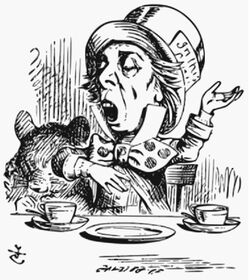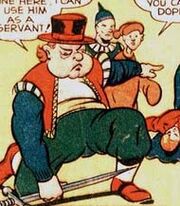| The Hatter | |
|---|---|
 | |
|
Real Name |
Hatta |
|
First Appearance |
Alice's Adventures in Wonderland (1865) |
|
Original Publisher |
Macmillan |
|
Created by |
Charles Lutwidge Dodgson (as "Lewis Carroll") |
Origin[]
The Hatter explains to Alice that he and the March Hare are always having tea because, when he tried to sing for the Queen of Hearts at her celebration, she sentenced him to death for "murdering the time," but he escapes decapitation. In retaliation, Time halts himself in respect to the Hatter, keeping him and the March Hare stuck at 6:00 forever. The tea party, when Alice arrives, is characterized by switching places on the table at any given time, making short, personal remarks, asking unanswerable riddles and reciting nonsensical poetry, all of which eventually drive Alice away. He appears again as a witness at the Knave of Hearts' trial, where the Queen appears to recognize him as the singer she sentenced to death, and the King also cautions him not to be nervous "or I'll have you executed on the spot."
When the character makes his appearance as "Hatta" in Through the Looking-Glass, he is in trouble with the law once again. This time, however, he is not necessarily guilty: the White Queen explains that, quite often, subjects are punished before they commit a crime, rather than after, and sometimes they do not even commit it at all. He is also mentioned as being one of the White King's messengers, and the March Hare appears as well as "Haigha", since the King explains that he needs two messengers: "one to come, and one to go."

Public Domain Literary Appearances[]
- Alice's Adventures in Wonderland
- Through the Looking-Glass, and What Alice Found There
- A New Alice in the Old Wonderland
Public Domain Film Appearances[]
- Alice in Wonderland (1903)
- Alice in Wonderland (1915)
- Betty in Blunderland (1934)
Public Domain Comic Book Appearances[]
- Pep Comics #23
- The Mad Hatter #1-2
- Santa Claus Funnies #2
- Adventures of Alice #1-2
- World's Greatest Stories #1
Notes[]
- He is often referred to as the Mad Hatter, though this term was never used by Carroll.
- The card or label on the Hatter's hat reads "In this style 10/6", which refers to 10 shillings and six pence (or a half guinea), the price of the hat in pre-decimalized British money. The figure acts as a visual indication of the hatter's trade.
- In the chapter "A Mad Tea Party," the Hatter asks a much-noted riddle: "Why is a raven like a writing desk?" When Alice gives up, the Hatter admits: "I haven't the slightest idea." Lewis Carroll originally intended the riddle to be without an answer; but after many requests from readers, he gives the explanation of: "Enquiries have been so often addressed to me, as to whether any answer to the Hatter’s Riddle can be imagined, that I may as well put on record here what seems to me to be a fairly appropriate answer: "Because it can produce a few notes, though they are very flat; and it is nevar [sic] put with the wrong end in front!" This, however, is merely an afterthought; the riddle as originally invented had no answer at all." Note that "nevar" is "raven" spelled "with the wrong end in front" (that is, backwards).